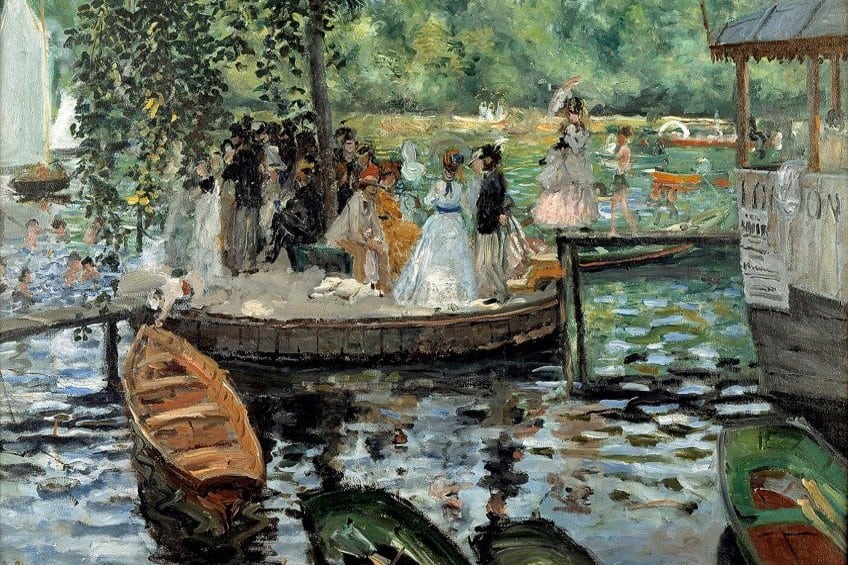French Impressionism – Explore Famous French Impressionism Art
Impressionism is one of the most influential and frequently-referenced art movements of all time. You may wonder how this movement began and who the masterminds behind this movement were. 19th-century Paris was the hub of art, which attracted many seasoned professionals from all parts of the world to indulge in the latest trends and developments of the European art scene. In this article, we will provide you with a refresher on French Impressionism and introduce you to some of the best French Impressionist artists and paintings that define the movement.
The French Impressionism Art Movement
The French Impressionism art movement is perhaps one of the most influential art movements in art history, famous for its expansion into the exploration of painting through experiments with light, color, and landscape painting. The French Impressionism art movement was founded by a group of French artists in 19th-century France, during the height of reliance upon the leading Parisian exhibition, Salon de Paris, and its dictator, the Académie des Beaux-Arts, which set the precedence for what art was considered to be good and what art was considered “outrageous”.
A Brief History of the Salon de Paris
The Salon de Paris was an annual exhibition that began in 1667 and was hosted by the Académie des Beaux-Arts, which essentially defined the artistic vision of French art and what was considered to be the standard for many artists. The Salon de Paris was the largest and most sought-after event for any artist to exhibit in and soon the event obtained a global status, thus attracting artists from far and wide to submit their works for consideration.
Initially, the focus of the Salon was to exhibit the work of artist graduates from the École des Beaux-Arts, which was founded by the Chief Minister of France in 1648.
The style of exhibiting work at the Salon involved a floor-to-ceiling display that covered as much space as was available and artwork would be judged by various art critics for all to see. This essentially set the bar for artists and their future careers, deeming their work worthy or ridiculous.
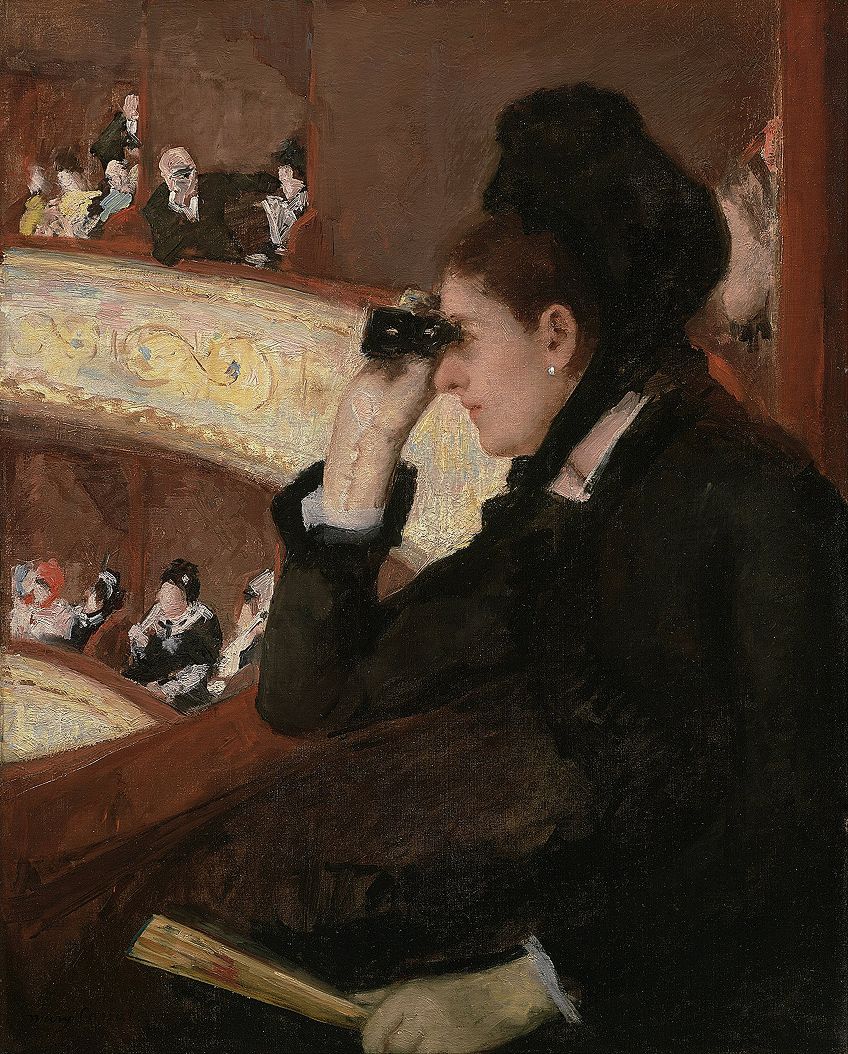
The French Salon was a result of the early 18th-century Enlightenment and provided extra accommodation for both female and male artists to engage in intellectual academic discourses. By the time the French Revolution occurred, the Salon had opened its doors to the international community and the 19th century established the Salon as an annual juried exhibition, sponsored by the government and open to the public.
Opening nights for the Salon was a major social event that attracted big names such as Charles Baudelaire and Denis Diderot to write about the event.
The political turbulence of 1848 resulted in a new liberal Salon and the number of artworks that were rejected saw a decline. Medals for talented artists were then introduced in 1849 and the juries became somewhat more conservative. When the first group of Impressionist painters decided to submit works for display, many jurors were unimpressed and often rejected them for deterring from the traditional painting standards of the time.

This, of course, escalated to a point where many Impressionist artists, or artists who sought to approach art differently, were angered by the clear hate for anything new. Napoleon III stepped in eventually to prove that the governance of the Salon was democratic and proceeded to hold another exhibition for the rejected artists, called the Salon des Refusés.
The exhibition was held in 1863 and is an iconic year to remember since it marked the onset of the Avant-Garde and newfound hope for Impressionists, who went on to host their own independent shows after receiving harsh backlash from the public.
The New French Impressionist Society
A group of artists came together in the 19th century to form their own society that rejected the academy and its ideals. This group came to be known as the Société Anonyme Coopérative des Artistes Peintres, Sculpteurs, Graveurs and consisted of French Impressionist painters such as Claude Monet, Pierre-Auguste Renoir, Berthe Morisot, Alfred Sisley, Edgar Degas, George Pissarro, and Paul Cézanne. This new society was founded on the basis that the artists involved would renounce any involvement with the Salon as an act of allegiance to the movement and thus invite other experimental artists to participate.
The first exhibition was held in 1874 with 30 participating artists.
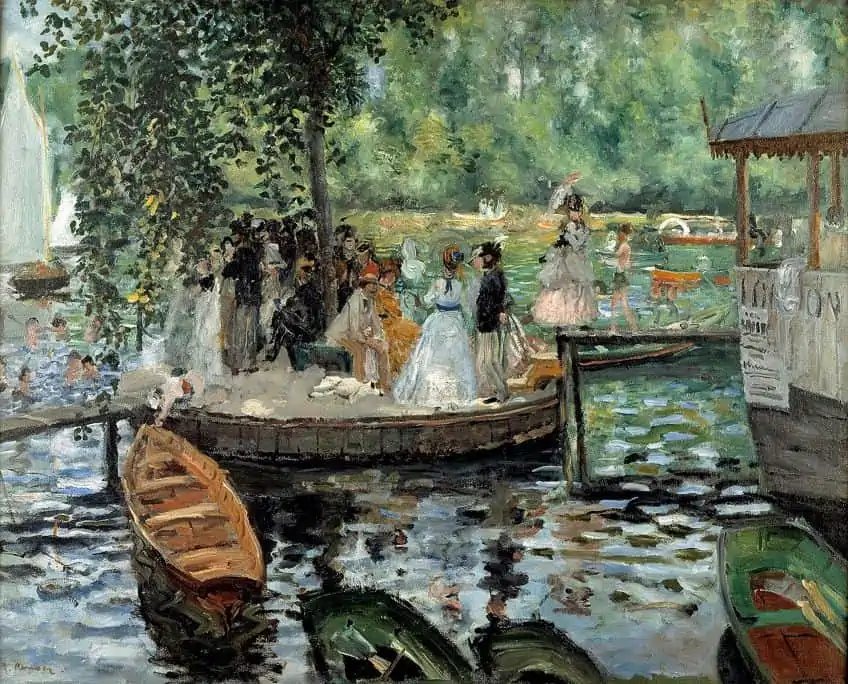
The Ideals of French Impressionism
The basis of French Impressionism was founded not only on the rejection of the Salon, its academic, traditional ideal, and all that it stood for but it was also founded on the desire for Contemporary subject matter, new painting techniques, landscapes, and experimentation with color and light. The newfound French Impressionist society did not last for very long since many artists chose to go their separate ways and jumpstart their careers.
Key pioneers to the founding of the movement include artists like Eugène Delacroix, Gustave Courbet, Eugène Boudin, Camille Pissarro, Georges Seurat, and others who inspired the most popular French Impressionist painters to dedicate their lives to the exploration of French Impressionism.
Some of the painting techniques, subject matter, and styles that were promoted by the French Impressionism art movement include visible brush strokes, non-traditional uses of color to represent changes in light as opposed to the ideal depiction of a scene, landscapes and modern subject matter as opposed to mythical and classical themes, and most importantly, the Plein air technique.
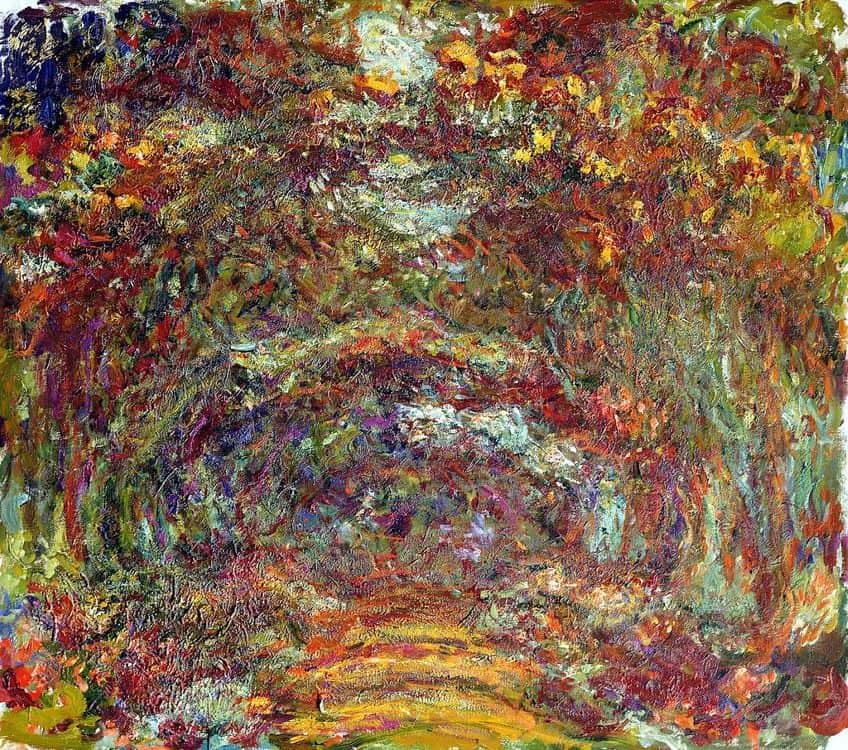
The Plein-air technique was first described in a treatise by the French painter, Pierre-Henri de Valenciennes, as part of his advice to students on landscape painting. This was described as a concept known as landscape portraiture and involved an artist painting in situ to capture the true essence or “portrait” of the landscape.
The Plein-air technique was later adopted by artists like Monet and other French Impressionist artists to capture an impression of the scenes of everyday life, landscapes, and personal interests.
Before this, another incredibly influential institution was the Barbizon School located in Barbizon, France, which promoted the act of painting in natural light conditions. The act of capturing natural light and its effect on color on the natural landscape was foundational to the French Impressionist movement and had an international grip on the Western art world as seen in the American Hudson River School, which was founded on the influence of the Barbizon ideals.
Popular French Impressionist Painters and Paintings
From the founding of the Salon des Refusés to the many group shows held by the French Impressionist group, many incredible works emerged through experimentation and the bravery of the French Impressionist painters to be bold and produce art regardless of the sharp-tongued art critic. Below, we will look at some of the most popular French Impressionist painters and paintings that encompass the essence of French Impressionism.
Camille Pissarro (1830 – 1903)
| Artist Name | Jacob Abraham Camille Pissarro |
| Date of Birth | 10 July 1830 |
| Date of Death | 13 November 1903 |
| Nationality | Danish-French |
| Most Famous Artworks | ● Two Women Chatting by the Sea, St Thomas (1856) ● The Hermitage at Pontoise (1867) ● La Récolte des Foins, Éragny (1887) ● The Boulevard Montmartre at Night (1897) |
Camille Pissarro was considered to be the father of all the French Impressionists and was admired for his dedication to French Impressionism and his role as the “dean” of the group. Pissarro supported the Impressionists through all eight of their exhibitions in Paris and first received inspiration from Camille Corot to paint en plain air after sticking to the academic standard of the Paris Salon.
It was not long before Pissarro began painting outdoor scenes and grew to admire and respect the practice of painting in the countryside.
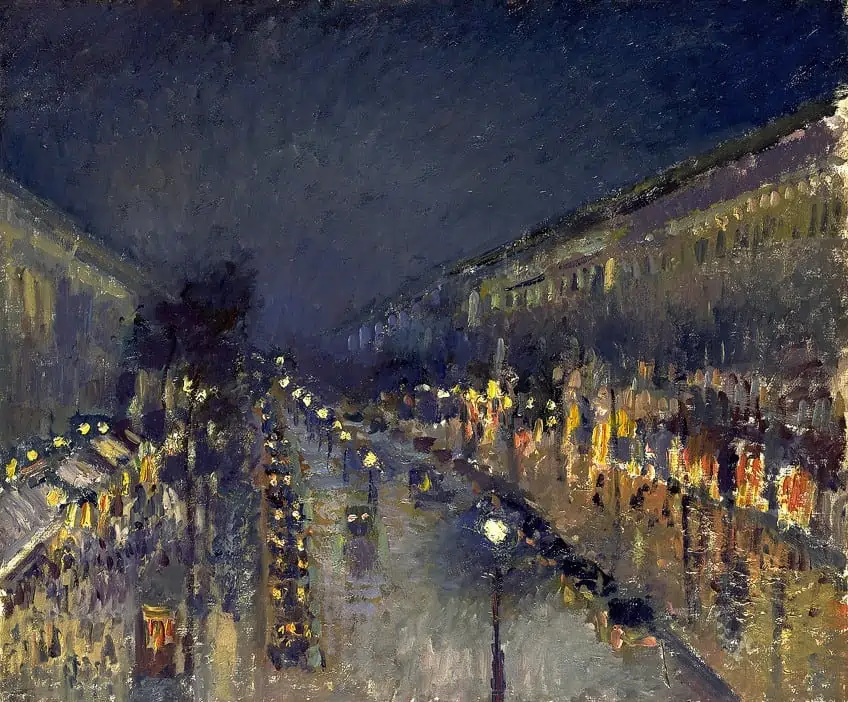
His advice on French Impressionist painting was to “paint generously”, without hesitation so as not to lose the first impression of the natural landscape. Pissarro created over 1,500 French Impressionist paintings during his time in France and after the war, he was shocked to discover that only 40 paintings remained.
Some of his most famous surviving works such as The Hermitage at Pontoise (1867) and The Boulevard Montmartre at Night (1897) are works that remind us of the birth of Impressionism.
The first Impressionist exhibition was critiqued as “vulgar” and looked down upon for its subject matter depicting scenes of common people and unkempt environments. Pissarro’s landscapes were among the works that were heavily criticized for this. Painting Plein air also meant that the painting was executed in one sitting and this left room for many “traditional errors”.
Édouard Manet (1832 – 1883)
| Artist Name | Édouard Manet |
| Date of Birth | 23 January 1832 |
| Date of Death | 30 April 1883 |
| Nationality | French |
| Most Famous Artworks | ● The Spanish Singer (1860) ● Music in the Tuileries (1862) ● Olympia (1863) ● Le Déjeuner sur l’herbe (1863) ● Le Suicidé (1877) ● Woman Reading (1880) |
Édouard Manet is one of the most essential French Impressionist painters whose “risky” approach to the subject matter and art made one of the largest impacts on not only the French Impressionist movement but also art history and the modernization of the female nude in art.
In 1863, Manet submitted Le Déjeuner Sur l’herbe to the Salon where it became a laughing stock for its depiction of a naked woman among a group of men in a casual picnic setting.
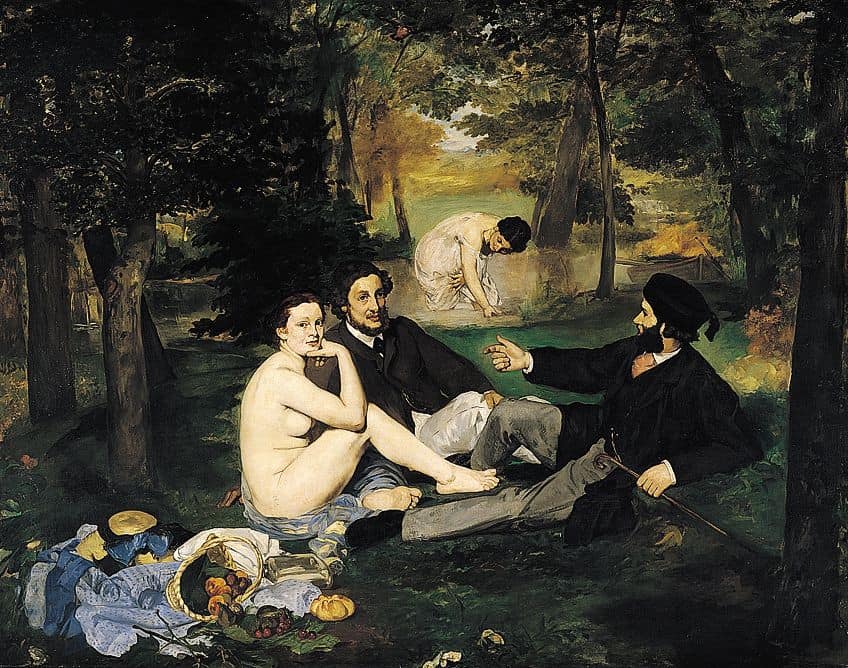
The scene can be regarded as contemporary and Manet was incredibly aware of this fact yet he knew that the Salon would be mortified. Nevertheless, Manet continued to exhibit works that shocked the public and juries at the Salon and became a pioneer of Modern art.
Among his most famous French Impressionist paintings are The Absinthe Drinker (1858-1859), The Spanish Singer (1860), Music in the Tuileries (1862), and Olympia (1863).
Marie Bracquemond (1840 – 1916)
| Artist Name | Marie Bracquemond |
| Date of Birth | 1 December 1840 |
| Date of Death | 17 January 1916 |
| Nationality | French |
| Most Famous Artworks | ● Self-Portrait (1870) ● Afternoon Tea (1880) ● The Lady in White (1880) ● On the Terrace at Sèvres (1880) ● The Artist’s Son and Sister in the Garden at Sevres (1890) |
Among the first three women to join the French Impressionist group, including Berthe Morisot and Mary Cassatt, Marie Bracquemond was a self-taught painter who created brilliant large Impressionist paintings that attracted much attention from the Impressionists.
Bracquemond exhibited with the group only a few times but had to soon abandon her career due to a lack of support from her husband, who was also an artist.
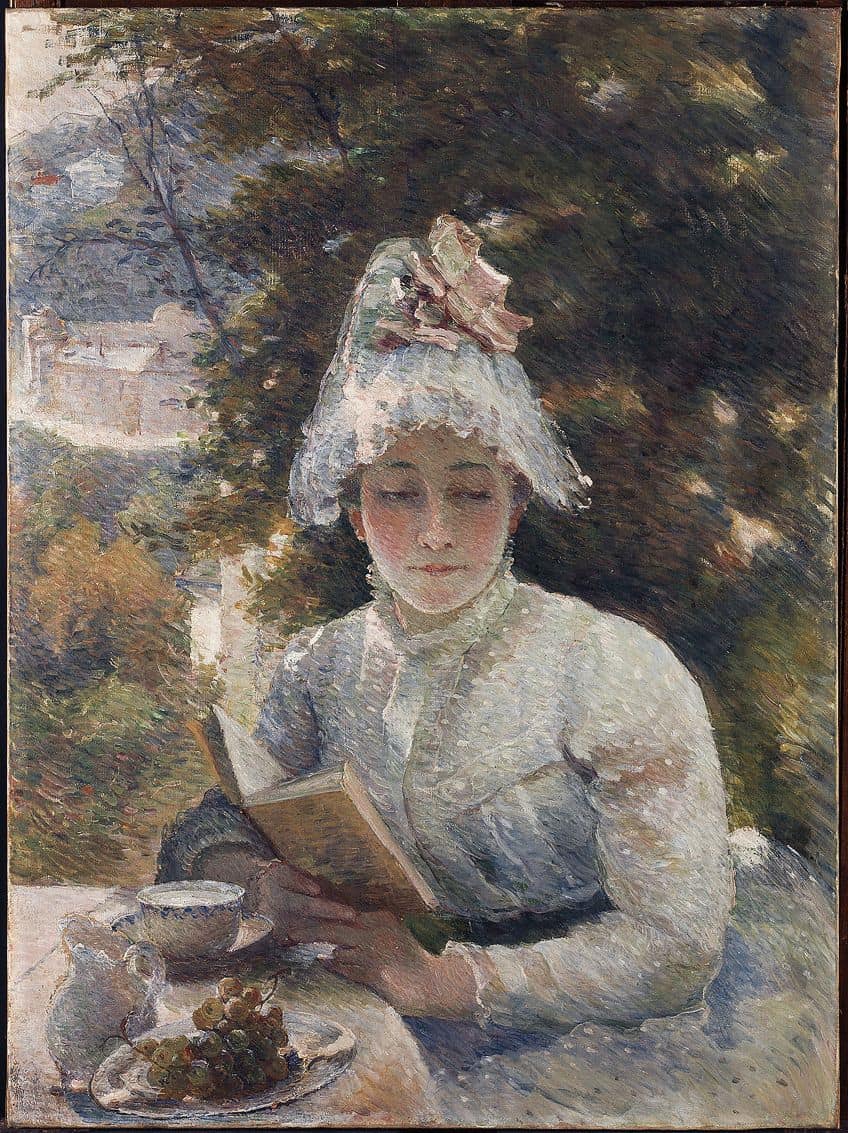
Bracquemond’s style was classical Plein air and displayed a sense of stability and calmness in color. Her works mimic the aesthetic of expired film photographs, which carry a softness and almost humble approach to capturing the subject. She portrayed subjects in both indoor and outdoor environments with her most striking painting being her Self-Portrait, created in 1870.
Claude Monet (1840 – 1926)
| Artist Name | Oscar-Claude Monet |
| Date of Birth | 14 November 1840 |
| Date of Death | 5 December 1926 |
| Nationality | French |
| Most Famous Artworks | ● Garden at Sainte-Adresse (1867) ● Impression, Sunrise (1872) ● Woman with a Parasol – Madame Monet and Her Son (1875) ● The Water Lily Pond (1899) ● Saint-Georges Majeur au Crépusculeii (1908 – 1912) |
Claude Monet is the most well-known French Impressionist and the most referenced painter in art history. Monet received public recognition for his first direct reference to Impressionism as seen in his 1872 painting, Impression, Sunrise, which sparked the term “Impressionism” coined by an art critic named Louis Leroy for Le Charivari newspaper.
Monet approached painting with his philosophy of painting natural scenes with his own perception of what he saw.

Monet saw widespread recognition as a painter during the latter half of the 20th century and is most famous for his Water Lily series (1840-1926). Artists whom he looked up to include other painters such as Eugène Boudin and Gustave Courbet from the Realism movement.
Monet’s best French Impressionist paintings include Camille Monet in Japanese Costume (1876), Poppy Field (1886), and Haystack at Giverny (1886).
Jean Frédéric Bazille (1841 – 1870)
| Artist Name | Jean Frédéric Bazille |
| Date of Birth | 6 December 1841 |
| Date of Death | 28 November 1870 |
| Nationality | French |
| Most Famous Artworks | ● La Robe Rose (1864) ● Family Reunion (1867) ● Portrait of Renoir (1867) ● Scène d’été (1869) ● L’Atelier de la rue Condamine (1870) ● Black Woman with Peonies (1870) |
Jean Frédéric Bazille is one of the most popular French Impressionist painters whose work took on a more creative approach to incorporating the human figure in various landscape settings. Bazille leveraged Plein-air painting in conjunction with figure painting to create some of the most iconic French Impressionist paintings such as L’Atelier de la rue Condamine (1870), which is currently housed at the Musée d’Orsay in Paris.
L’Atelier de la rue Condamine captures the studio that Bazille shared with Pierre-Auguste Renoir in Paris at the rue de la Condamine.

Bazille can be seen in the center of the painting holding a letter in his hand Bazille’s friend, Edmond Maître, is seen seated on the right at the piano while Manet is seen on the left wearing a hat. The identity of the two other figures on the left is unclear but is believed to be either Monet, Renoir, or Zacharie Astruc. So, what makes this one of the best French Impressionist paintings? Bazille cleverly included all paintings in the background that were rejected by the Salon and this was meant to serve as a critique of the academy while re-affirming his viewpoint on “good art”.
Bazille later joined the Franco-Prussian war where he died in combat.
Berthe Morisot (1841 – 1895)
| Artist Name | Berthe Marie Pauline Morisot |
| Date of Birth | 14 January 1841 |
| Date of Death | 2 March 1895 |
| Nationality | French |
| Most Famous Artworks | ● The Cradle (1872) ● At the Ball (1875) ● Woman at Her Toilette (1880) ● Devant la Psyché (1890) ● Julie Daydreaming (1894) |
Berthe Morisot was one of the first female French Impressionist painters to join the original Impressionist group, which was at the time, predominantly occupied by male contemporaries. Morisot’s works express a gentle yet imaginative play with color and light as seen in some of her best works.
She exhibited at the Paris Salon in 1864 and married Manet’s brother, Eugène Manet, who was also a French painter but did not succeed in reaching the same level of recognition as his wife and brother but he did continue to support both of them.

Morisot was also an expert watercolorist before exploring her talents in oil painting and this inspired the light, feathery atmosphere in some of her famous oil paintings such as Eugène Manet on the Isle of Wight (1875) and Devant la Psyché (1890).
Pierre-Auguste Renoir (1841 – 1919)
| Artist Name | Pierre-Auguste Renoir |
| Date of Birth | 25 February 1841 |
| Date of Death | 3 December 1919 |
| Nationality | French |
| Most Famous Artworks | ● La Grenouillère (1869) ● Bal du moulin de la Galette (1876) ● Portrait of Irène Cahen d’Anvers (1880) ● Luncheon of the Boating Party (1881) ● Les Grandes Baigneuses (1884 – 1887) ● Reclining Nude from the Back, Rest after the Bath (1909) |
Pierre-Auguste Renoir created some of the most iconic and well-composed French Impressionist paintings. Renoir captured the sensuality and beauty of women and was inspired by leading Impressionist artists like Monet, Pissarro, Courbet, and Manet. Renoir’s character can be seen through the facial expressions of his subjects who appear to be aware of his presence yet delighted to be painted by Renoir. Many of his subjects display an eagerness to be painted and appear to enjoy the company of the artist.
One of Renoir’s most famous French Impressionist paintings is the Luncheon of the Boating Party (1881), which portrays around 13 figures, each rendered with unique expressions while enjoying lunch on the boat.

Renoir also captures the visible details of the items on the lunch table so beautifully that it appears inviting and does not blend in with the rest of the Impressionistic style of the figures and background. It provides room for clarity amidst the crowd of people. Some of Renoir’s best works also include La Parisienne (1874), Dance in the City (1883), Young Girl with Red Hair (1894), and Woman with a Mandolin (1919).
Among the other famous French Impressionist artists are Paul Cézanne, Alfred Sisley, Gustave Caillebotte, Paul Gauguin, and Edgar Degas who all played a significant role in broadening the nature and possibilities of Impressionism. The French Impressionism art movement remains one of the most impactful art movements in history, which has allowed artists to embrace non-traditional subjects, painting techniques, and narratives that paved the way forward for Modernism. We hope that this refresher on French Impressionism has enlightened you on the ways that artists can come together to effect positive change amidst challenging contexts.
Frequently Asked Questions
What Is French Impressionism?
French Impressionism was a 19th-century art movement that emerged in Paris as an act of revolution against the traditional modes of painting and subject matter featured in academic painting, as defined by the Académie des Beaux-Arts. French Impressionism focused on subject matter that displayed everyday life, landscapes, and the changes of color that occurred in the natural environment.
Who Is the Most Famous French Impressionist?
The most famous French Impressionist is considered to be Claude Monet who is regarded as one of the founding fathers of the movement, alongside Frédéric Bazille, Camille Pissarro, Edgar Degas, Pierre-Auguste Renoir, Alfred Sisley, Paul Gauguin, Berthe Morisot, and preceding artists such as Gustave Courbet and Eugène Delacroix.
What Are the Characteristics of French Impressionist Painting?
The characteristics of French Impressionist painting include visible brushstrokes, an emphasis on the depiction of light, and unblended colors. Other characteristics include the use of painting techniques and approaches such as en Plein air and impasto to render subjects set in landscapes, natural settings, and Modern scenarios.
Jordan Anthony is a Cape Town-based film photographer, curator, and arts writer. She holds a Bachelor of Art in Fine Arts from the University of the Witwatersrand, Johannesburg, where she explored themes like healing, identity, dreams, and intuitive creation in her Contemporary art practice. Jordan has collaborated with various local art institutions, including the KZNSA Gallery in Durban, the Turbine Art Fair, and the Wits Art Museum. Her photography focuses on abstract color manipulations, portraiture, candid shots, and urban landscapes. She’s intrigued by philosophy, memory, and esotericism, drawing inspiration from Surrealism, Fluxus, and ancient civilizations, as well as childhood influences and found objects. Jordan is working for artfilemagazine since 2022 and writes blog posts about art history and photography.
Learn more about Jordan Anthony and about us.
Cite this Article
Jordan, Anthony, “French Impressionism – Explore Famous French Impressionism Art.” artfilemagazine – Your Online Art Source. December 9, 2022. URL: https://artfilemagazine.com/french-impressionism/
Anthony, J. (2022, 9 December). French Impressionism – Explore Famous French Impressionism Art. artfilemagazine – Your Online Art Source. https://artfilemagazine.com/french-impressionism/
Anthony, Jordan. “French Impressionism – Explore Famous French Impressionism Art.” artfilemagazine – Your Online Art Source, December 9, 2022. https://artfilemagazine.com/french-impressionism/.


